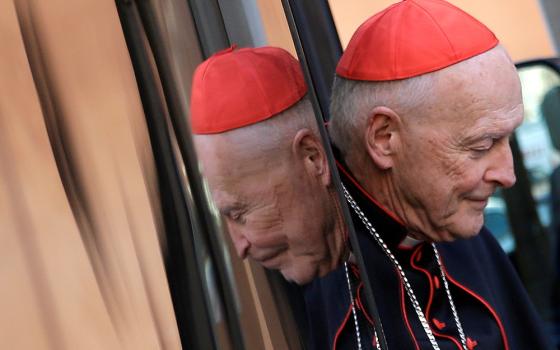“It’s not like we’re in a crisis; it’s not like all of a sudden we need some daring new initiatives,” Archbishop Timothy Dolan of New York declared during his acceptance speech following his stunning election as president of the United States Conference of Catholic Bishops.
The archbishop was thanking God for the work of his soon-to-be predecessor, Cardinal Francis George of Chicago, whose strict opposition to health care reform -- because it might expand financing for abortion -- and gay marriage Dolan promised to uphold.
But just days later Dolan gave an interview to The New York Times admitting his concern that only half of young Catholics marry in the church and that weekly Mass attendance has dropped to about 35 percent -- down from its peak of 78 percent in the 1960s.
He lamented that the throngs of people on Fifth Avenue are not waiting to get into New York’s St. Patrick’s Cathedral, but rather, the neighboring Abercrombie and Fitch store.
“Wow,” Dolan sighed, “there’s no line of people waiting to get into St. Patrick’s Cathedral, and the treasure in there is of eternal value. What can I do to help our great people appreciate that tradition?”
I wonder how often the archbishop and his fellow hierarchs stop to ask what it is about the tradition that makes it great. What aspects of it would speak to the hearts of young adults?
Is it the continued shaming of gays and lesbians? Or is it the mandate to feed, clothe, shelter, and comfort the poor?
Is it the legacy of fighting for a just wage and adequate health benefits for all laborers?
Is it the fixation on contraception (which has driven more than one couple away from the Pre-Cana process)? Or is it the life-giving, mystical tradition of meditation and prayer?
Is it the rigid, unjustifiable exclusion of women from ordained leadership? Or is it the sacramental tradition that says that all finite things in nature are capable of revealing transcendent, eternal meanings?
Does the archbishop really not recognize that church attendance was at its peak when the institution made its greatest effort to engage with spiritual needs and moral dilemmas of the modern world? Does he really not see the failing relationship between young adults and Catholicism as a crisis?
In the photo accompanying his interview Dolan dons his full cassock, seated in a well-appointed parlor of his residence located on the poshest stretch of Madison Avenue. Mahogany doors highlight the backdrop and a priceless Persian rug lines the floor. Dolan seems to be comfortable surrounded by many of the same the luxuries sought by many of those frantically shopping in the street below.
For younger generations, image communicates everything. If they see a religious leader living a detached life on the elite East Side of Manhattan, where is the motivation for them to stop storing up treasures on Fifth Avenue and seek instead the treasures in Catholic doctrine?
Young Catholics’ knowledge of their faith may be waning, but their images of Jesus are likely clear and consistent.
To them, Jesus was born in a stable and was probably poor for most of his adult life. He fed the hungry and healed the sick. He showed compassion to outcasts and asked us to love one another as God loves us. These are the ideals that young adults expect religious leaders to try to honor.
On their way to Abercrombie, most young Catholics surely passed dozens of homeless men and women -- many of them mentally ill or addicted -- huddled on sidewalks or napping in the corner of subway cars. W
ere these young folks to have seen Dolan stopping to chat with a panhandler or hand out sandwiches to someone resting on the sidewalk, he might have done the nearly impossible: he might have captured the undivided attention of young, frenzied shoppers. He also would have embodied one of the eternal treasures of the tradition.
But young people trust the images they see. If the institutional church identifies itself regularly with being anti-gay, anti-woman, and anti-sex, how many young people will enter a cathedral expecting to have their questions and worries heard by a compassionate, humble minister? How many will feel genuinely welcome in the cathedral without the dread of feeling judged and shamed?
The archbishop is right. There is nothing of eternal value in any retail store. But without spiritual leadership that is willing to engage them in their reality, where else should they turn for support? At least Abercrombie helps them feel better about themselves. Though it won’t last an eternity, looking good can offer a brief escape from the sufferings and worries that wrack our minds and hearts.
Perhaps Dolan and the Abercrombie set have more in common than they realize. Both are mastering the art of avoiding reality. Dolan strives to create an image of a well-ordered, vigorous institution that masks its fears of losing power and influence. The Abercrombie kids strive to create an image of sexiness that covers up fears of being fragile, unlovable, and alienated.
For the archbishop, Abercrombie symbolizes the death of young adults’ interest in the treasures of the church. For young adults, Abercrombie symbolizes the power of style and hipness that numb us from our existential anxieties of suffering, loss, and death.
The season of Advent celebrates the risk that God took to engage human beings. We find hope in God’s strikingly vulnerable act of entering human flesh and experiencing life in all of its joy, sorrow, absurdity, and uncertainty. It is the time of year when we should try to emulate this divine act by engaging more deeply with other human beings in the hope that these encounters will help us to know God more fully.
Instead we have a hierarchy that is too afraid of admitting its vulnerability as an ailing institution among the young, and we have young people too afraid of their vulnerability as finite human beings to be able to contemplate questions of an ultimate meaning.
Church leaders who are unwilling to admit their own vulnerabilities cannot truly be present to the vulnerabilities of the young people they seek to guide. Young people will only listen to religious leaders who practice their own teachings and admit their own vulnerability, limitations, and sinfulness.
If the archbishop and the men he leads wish to have young people enter their cathedrals, they should take the risk of going into the streets and meeting them not as authoritarians but as humble servants.
They should begin by admitting that they are in crisis and ask young Catholics what new initiatives are needed to breathe new life into expiring church institutions.
Only then will the Archbishop have a chance to compete with Abercrombie.
[Jamie L. Manson received her Master of Divinity degree from Yale Divinity School where she studied Catholic theology and sexual ethics. Her columns for NCR earned her a first prize Catholic Press Association award for Best Column/Regular Commentary in 2010.]
| Editor's Note: Jamie Manson has been writing a Web column for NCR since November 2008 when she premiered as one of our "Young Voices" columnists. Last month, NCR invited and Manson agreed to become a weekly columnist under her own title. "Grace on the Margins" is the result. It will appear here every Monday.
Why is this column titled Grace on the Margins? Read Manson's inaugural column: The grace of living on the margins. We can send you an e-mail alert every time Jamie Manson’s column, "Grace on the Margins", is posted to NCRonline.org. Go to this page and follow directions: E-mail alert sign-up. If you already receive e-mail alerts from us, click on the "update my profile" button to add "Grace on the Margins" to your list. |




